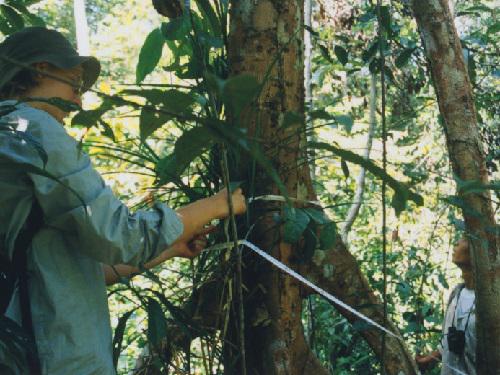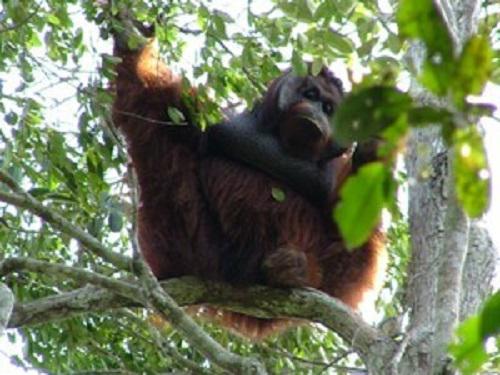Simon Husson
This project aims to design and implement an ecological-monitoring program in the Sabangau Forest that provides practical and constructive feedback for conservation management activities.

Rachel measuring copy.
The Sabangau Forest supports the world’s largest population of Bornean orang-utan, - 6900 individuals in an area of 578,000 hectares of peat swamp forest - and one of the largest populations of Bornean agile gibbon, Hylobates albibarbis. Both species are at risk throughout their range from logging, conversion of forest for agriculture, fire and hunting, and thus the Sabangau is recognized as crucial for the survival of these species. Although the area has recently been given protected-area status, this forest is not immune from these problems, and there are many challenges ahead.

Flanged male orangutan in the Sabangau Forest.
Several conservation initiatives are underway by our Indonesian partners CIMTROP, but the effectiveness of these must be evaluated against the objectives of maintaining (and improving) the structure and integrity of the forest habitat, its plant and animal populations and the ecological processes and functions contained within. This necessitates regular and rigorous scientific monitoring - frequently neglected in protected-area planning, but a crucial component of active management. A sound, comprehensive scientific foundation to protected-area management is repeatedly recommended by experts as crucial to conservation success. Ecological monitoring can be used to evaluate the success of conservation actions, identify problems and adapt to changing situations.
We will design and implement a long-term ecological monitoring project within the Sabangau peat-swamp forest. This will focus on endangered orang-utan and gibbon populations by monitoring trends in their density and the condition of their forest habitat.
Monitoring of this kind is crucial to any protected-area management program, by providing a mechanism to assess the effectiveness of conservation measures. We have already demonstrated the effectiveness of our CIMTROP’s activities at our core research site by monitoring orang-utan since 1999, and we will expand and develop this project by establishing four new remote monitoring stations, expanding the range of target indicators, collect baseline data, write and translate a protocol and produce training and educational DVD’s on this work.